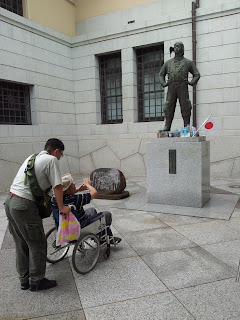Non embraced defeat 67 years after World War Two
The Yasukuni shrine, located in central Tokyo, honors more than 2 million Japanese who died in the war, but causes resentment because it includes 14 convicted war criminals who committed atrocities across the region.
China said it would lodge a complaint with Japan after it detained five Chinese activists who landed on a disputed island on August 15 as tension between Japan and its neighbors escalated on the anniversary of the end of World War Two.
Amid a sudden outburst in nationalistic anti-Japan rhetoric, South Korean President Lee Myung-Bak fueled it further with a demand for an apology by Emperor Akihito for the repression during colonial time.
The Yasukuni shrine has long been a source of tension between the two countries, but the visits today came amid a diplomatic deadlock that began last week after South Korean President Lee Myung-Bak visited the disputed Takeshima islands known as "Dokdo" in Korean, despite protests from Tokyo. That immediately prompted Japan to withdraw its ambassador from Seoul, ambassador Muto Masatoshi.
Maybe the Koreans used the division of a weakened Japan government as seen today with 2 cabinet ministers of the Democratic party who visited the Yasukuni Shrine, seen as a symbol of Japan imperialism. National Public Safety Commission Jin Matsubara and Transport Minister Yuichiro Hata were the first two high-ranking officials to visit Yasukuni Jinja since the ruling Democratic Party of Japan came to power three years ago.
Every summer, these hostilities are a customary pattern for neighbors nationalistic views. Time has come, though, for authentic reconciliation and cultural tolerance in north-east Asia. These photos were taken at Yasukuni Shrine Tokyo today August 15th 2012, the day when Pacific war ended with Japan defeat, we understand some here do not give up the fight 67 years after surrendering. A non embraced defeat from Japan and a continuing poisonous atmosphere between former belligerents.
A minority some people say, not sure and I see more young people than ever. The memories of uniforms hurt regional sensibilities, Korea, China, SE Asia, in Japan and in the western world. Duty of remembrance is rather seen in this part of Asia as a duty to create and activate anger among Asian nations. Apparently, good reasons to let the two big policemen monitor the region as here the Cold War is still on. And wait, we have not heard about north Korea nuclear bomb threats yet!
Still one has to understand the motives of ordinary people and families who, as one father under 50 and his son told me today, let's call him Hamada-san: "For us it is a day of remembrance, we were crushed in these war events, today we wish to offer our country peace and dignity and some Japanese politicians seem strong enough to defend Japan."
Invasions, war and peace and the impact on societies. Tolstoi was right...
1 minute of silence at 12:00 for the Japanese war victims
Nationalists in black uniform
Ultra conservative Abe Shinzo former Prime Minister
Abe and his followers
Crowds invade the Yasukuni shrine
1 hour to go from the Tori to the shrine
Nationalists or more... they belong to Yasukuni donators
Like soldiers, they pay respect to the "boss"
Crowds continue their visit of the shrine
The Yushukan museum. Historically correct until Meiji Revolution
Nostalgic of the "Kamikaze fighters"
Ipadding the fighter plane
When Japan and Germany were allied of the Axis powers
Indian nationalist Chandra Bose is venerated at Yasukuni
Maritime map of the Empire
Yasukuni "Gods" as portrayed by Yasukuni priests
This one was lost in translation time machine, awful.
More peaceful, an harmonious garden at the Chidorigafuchi, ten minutes walk from the Yasukuni and unrelated. It is the national Japanese cemetery for 353.000 unidentified war dead in the Second World War
A lot of police forces deployed at Kudanshita area of Tokyo
-Copyright © JLK 2012 August 15-
* Territorial dispute, news update. August 17th *
China-Japan: Japanese officials have decided to deport fourteen Chinese activists and journalists accused of illegally entering the country’s territory. They were seized when they landed on an island that Japan controls, but China claims.
South Korea - Japan: About the dispute between Japan and south Korea after South Korean President Lee Myung-Bak visited the islands, Japan’s Chief Cabinet Secretary Osamu Fujimura said that his country wants to deal with the dispute calmly, under international law and proposed to the South Korean government that the country take the case to the International Court of Justice. South Korea’s foreign ministry dismissed the proposal.
I add to this post on my blog this program "Une semaine en Asie : Nouvelles du Japon, "Patriotisme" de Yukio Mishima", aired on the French radio (France Culture) August 15th 2012. Text read by Bernard Lanneau (originally recorded in 1987)
* Territorial dispute, news update. August 17th *
China-Japan: Japanese officials have decided to deport fourteen Chinese activists and journalists accused of illegally entering the country’s territory. They were seized when they landed on an island that Japan controls, but China claims.
South Korea - Japan: About the dispute between Japan and south Korea after South Korean President Lee Myung-Bak visited the islands, Japan’s Chief Cabinet Secretary Osamu Fujimura said that his country wants to deal with the dispute calmly, under international law and proposed to the South Korean government that the country take the case to the International Court of Justice. South Korea’s foreign ministry dismissed the proposal.




















